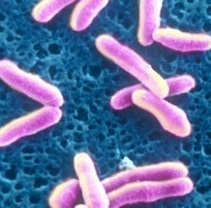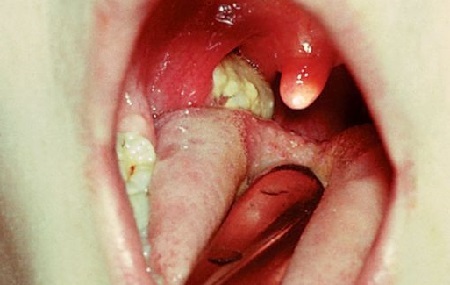 Diphtheria is an acute infectious disease caused by diphtheria bacteria, transmitted mainly by airborne droplets, characterized by inflammation, most often the mucous membranes of the mouth and nasopharynx, as well as the phenomena of general intoxication, the defeat of the cardiovascular, nervous and excretory systems.
Diphtheria is an acute infectious disease caused by diphtheria bacteria, transmitted mainly by airborne droplets, characterized by inflammation, most often the mucous membranes of the mouth and nasopharynx, as well as the phenomena of general intoxication, the defeat of the cardiovascular, nervous and excretory systems.
The causative agent of diphtheria is the toxigenic strain of the diphtheria microbe. It looks like a stick with a thickening at the ends. Microbes are arranged in the form of the letter V. They release dangerous poisons - exotoxin and neuraminidase. In addition, they break down cystine and ferment glucose, able to restore nitrates to nitrites.
In connection with the ability of microorganisms to ferment starch, the disease was divided into three clinical forms: the first - mild, with which starch is not fermented, the second - medium, intermediate, the third - heavy, with the ability to ferment the starch. But in fact such a relationship does not exist at all. Toxins are capable of producing only the largest individuals of a microorganism.
Diphtheria causative agent
Why does diphtheria develop, and what is it? The incubation period for diphtheria varies from 3 to 7 days. Diphtheria manifestations are diverse and depend on the localization of the process and its severity.The source of infection is a person. Transmission of the pathogen is mainly carried out by airborne droplets, but infection is possible and contact-household (through infected items). Diphtheria is characterized by autumn-winter seasonality. In modern conditions, when adults are mostly sick, diphtheria occurs throughout the year.
The causative agent of diphtheria is a diphtheria bacillus, the carrier of which is a sick person or a person carrying an infection during the incubation period of diphtheria bacillus, and also for some time after recovery.
Symptoms of diphtheria
The incubation period for diphtheria is from 2 to 10 days. When diphtheria bacillus penetrates the body at the site of its introduction, an inflammatory focus develops in which the pathogen multiplies, releasing toxin.
With the lymph and blood toxin spreads throughout the body, causing damage to both the mucous membrane (or skin) at the site of the pathogen, and internal organs and systems. Since the pathogen most often penetrates into the pharynx, local changes most often occur in it. In addition, the inflammatory focus can develop in the nose, larynx, ear, on the genitals, eyes, the wound surface of the skin.
Symptoms of diphtheria depend on the location of the pathogen. Among the general symptoms characteristic of all forms of the disease, we can distinguish the following:
- thick gray raids covering the throat and tonsils;
- pain in the throat and hoarseness of the voice;
- enlargement of lymph nodes of the neck and edema around them (so-called "bull's neck");
- shortness of breath or frequent breathing;
- discharge from the nose;
- fever and chills;
- general malaise.
Symptoms of diphtheria depending on the clinical form:
- Most often (in 90% of all cases oforopharyngeal diphtheria. The duration of the incubation period is from 2 to 10 days (from the moment of contact of the person with the bacterial carrier). When Leffler's wand penetrates the mucous membrane of the mouth, it damages it and causes tissue necrosis. This process is manifested by severe edema, the formation of exudate, which is subsequently replaced by fibrin films. Difficult plaque covers the tonsils, can go beyond them, spreading to neighboring tissues.
- When the diphtheria croup can be affected by the larynx, bronchi, trachea. There is a strong cough that leads to the fact that the voice becomes hoarse, the person pales, it is difficult to breathe, the heart rhythm, cyanosis is broken. There is a weak pulse, blood pressure drops sharply, a disorder in the mind can disturb the convulsive state. Dangerous form is that which can lead to suffocation and death.
- Diphtheria of the nose. In cases with diphtheria of the nose, a very insignificant intoxication of the body, supernumerary discharge, serous-purulent discharge, difficulty breathing with the nose will be characteristic. In this form of diphtheria, the mucous membrane of the nose: edematous, hyperemic, with ulcers, with erosions or fibrinous overlap (it is easy to remove, look like shreds). Also on the skin around the nose, wax irritations and crusts. Basically, the diphtheria of the nose manifests in combination with: diphtheria of the oropharynx, sometimes the eye, and (or) the larynx.
- With prevalent diphtheriafirst the body temperature rises to thirty-eight degrees and above. Patients move less, feel tired, sometimes there are attacks of nausea and vomiting. The plaque on the tonsils already in a couple of days is spreading all over the oral cavity - to the tongue, throat, the sky. Lymph nodes are significantly enlarged, they are painful when palpated.
- Toxic formComplication of untreated previous forms. Body temperature rises to 40 ° C, symptoms of intoxication syndrome appear: chills, weakness, joint pain, choking in the throat. In patients there is vomiting, agitation, euphoria and delirium. The skin pale, and the mucous membrane of the throat swells and turns red. Possible complete closure of the larynx lumen. Fibrinous plaque covers most of the mucous membrane of the oropharynx, while the films become coarse and thick. In patients, cyanosis of the lips appears, palpitation increases, blood pressure drops, and an unpleasant, putrid smell comes from the mouth.
Treatment of diphtheria at an early stage provides complete recovery, without any complications, although the duration of the cure depends on the severity of the infection. In the absence of timely treatment, serious complications, including the heart, are possible, which can lead to coma, paralysis or even death.
Diagnostics
Diagnosing diphtheria is difficult, because the symptoms are similar to a number of other diseases - angina, stomatitis, etc. In order to accurately establish the diagnosis and prescribe the proper treatment, laboratory research is needed:
- Bacteriological (swab from the oropharynx). With the help of this method, the pathogen is isolated and its toxic properties are established;
- Serological. Ig G and M are determined, indicating the intensity of immunity, which indicate the severity of the inflammatory process;
- The PCR method is used to establish the DNA of the pathogen.
It is also necessary to carry out diagnosis of complications caused by diphtheria.
Diphtheria: photo
How people with diphtheria look, the photo is shown below.
 Diphtheria of the oropharynx, localized form. Fleshy coating on the left tonsil.
Diphtheria of the oropharynx, localized form. Fleshy coating on the left tonsil.Complications
The causes of complications are exposure to toxins of diphtheria bacillus on the body and later introduction of serum:
- myocarditis;
- infectious-toxic shock;
- DIC-syndrome;
- defeat of the adrenal glands;
- multiple organ failure;
- respiratory insufficiency;
- poly- or mononeuritises;
- toxic nephrosis;
- cardiovascular failure;
- otitis;
- pneumonia;
- paratonsillar abscess, and others.
The time of appearance of the complications described above depends on the type of diphtheria and the degree of its severity. For example, toxic myocarditis can develop in the 2-3 week of the disease, and neuritis and polyradiculoneuropathy - against the background of the disease or 1-3 months after complete recovery.
Treatment of diphtheria
Regardless of the severity of diphtheria, treatment in children and adults is done in a hospital (in a hospital). Hospitalization is mandatory for all patients, as well as patients with suspected diphtheria and bacterial carriers.
When confirming the presence of diphtheria, antitoxic antidiphtheria serum is immediately administered, which helps to neutralize exotoxin in the blood. The dose of antidiphtheria serum is determined by the severity of the disease. If you suspect a localized form, you can delay the introduction of serum until the diagnosis is clarified. If the doctor suspects the toxic form of diphtheria, then serum treatment should be started immediately. Serum is administered intramuscularly or intravenously (with severe forms).
In combination with serum prescribe antibacterial drugs. Of the entire spectrum, erythromycin (as well as penicillin, ampiox, ampicillin, tetracycline) is most popular, which destroys the pathogen. Already at this stage a person does not just begin to recover, but his body is no longer exposed to the diphtheria bacillus, which is the most important at the time of diagnosis.
Another important aspect in the treatment of diphtheria is the weakening of the body's intoxication. To do this, use the introduction of polyionic solutions, glucocorticoids, potassium mixture. If such measures do not bring a result, then the cleansing of blood (plasmapheresis) is indicated.
Prevention
Nonspecific prevention consists in observing the following rules:
- Timely identify and isolate patients and bacterial carriers.
- Carry out current and final disinfection.
- One time to examine all persons who were in contact with the patient.
- Follow the patients with angina for three days.
- Conduct an annual medical examination of schoolchildren.
- Observe the convalescent diphtheria within 3 months after discharge from the infectious department.
Vaccination against diphtheria
The most effective prevention of diphtheria is active vaccination. This is the introduction of a small number of bacilli, which stimulate the body to produce antibodies. Although these antibodies do not interfere with diphtheria infection in the future, they can neutralize the causes of complications - bacterial toxin, and, thus, to weaken the progression of the disease (antitoxic immunity).
You can vaccinate against diphtheria in any inoculum. Vaccination against diphtheria is included in the National Calendar of preventive vaccinations. Vaccination for children is carried out in three stages (at 3, , and 6 months). At 18 months, 6-7 and 14 years of age carry out revaccinations. After this, children and adults should be vaccinated against diphtheria every 10 years.
After the transferred disease, unstable immunity forms, and after about 10-11 years a person may get sick again. The second disease is of a mild nature and is easier to tolerate.
Forecast
In the case of localized forms of diphtheria of the lung and moderate course, as well as the timely administration of antitoxic serum, the prognosis for life is favorable. To aggravate the prognosis can a severe course of toxic form, the development of complications, later the beginning of medical activities.
At present, due to the development of patient care facilities and mass immunization of the population, mortality from diphtheria is no more than 5%.

How to choose probiotics for the intestine: a list of drugs.

Effective and inexpensive cough syrups for children and adults.

Modern non-steroidal anti-inflammatory drugs.

Review of tablets from the increased pressure of the new generation.
 Antiviral drugs are inexpensive and effective.
Antiviral drugs are inexpensive and effective.



